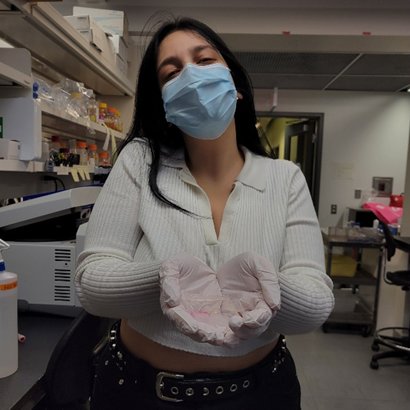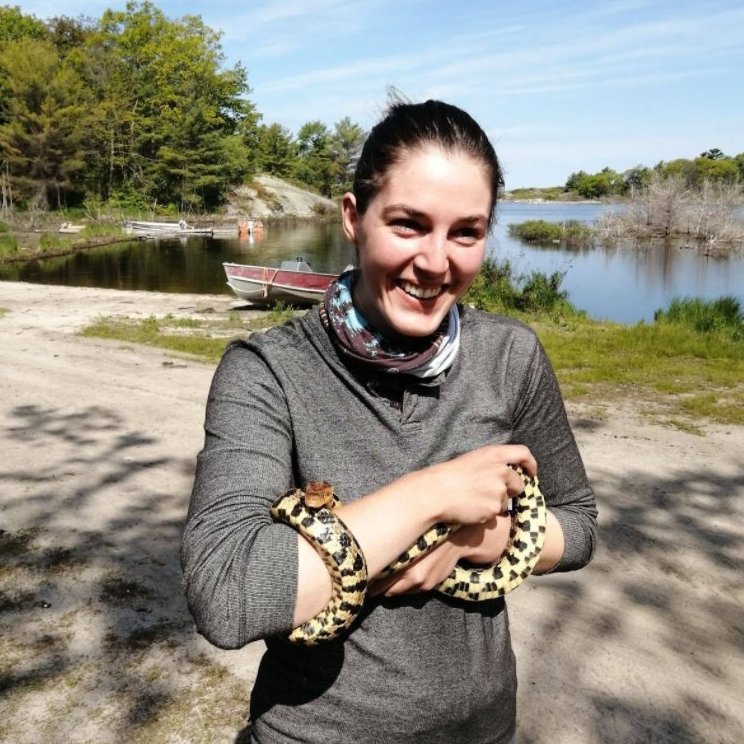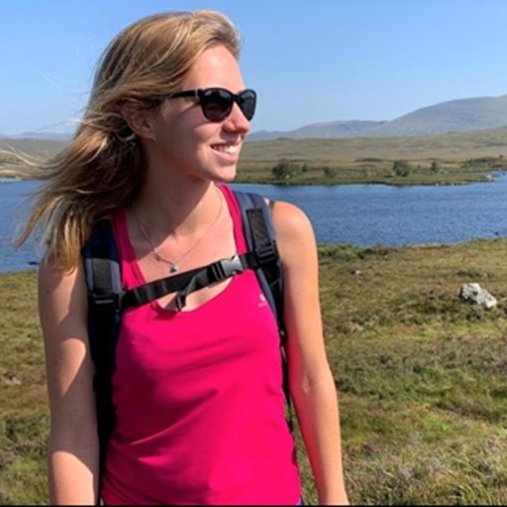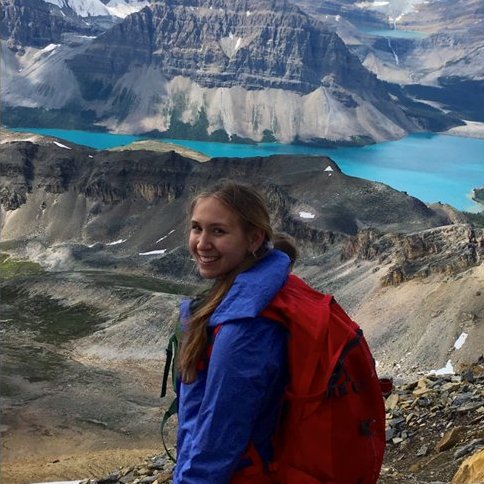![]()
 Flavio Affinito, Gonzalez Lab
Flavio Affinito, Gonzalez Lab
My work is part of ResNet, a pan-Canadian effort to monitor, model and manage the nation’s land and sea-scapes. I focus on understanding how social and environmental networks behave and affect each other. Specifically, my goal is to develop a monitoring framework for ecosystem services to better protect and preserve the natural capital we rely on. Currently, I am focused on the marine landscape of British-Columbia looking at how water quality, salmon fisheries, whale watching, and endangered species habitats are affected by human influence and how they are changing over time. Additionally, I am testing a new monitoring approach for sea otters along the coast in order to protect this endangered species whilst safeguarding food security of local people who rely on sea otter prey for food. I plan to take away key lessons from this work to allow for the design of ecosystem service monitoring in other regions.
 Alex Berger, Reader Lab
Alex Berger, Reader Lab
Exploration and social learning are core behaviours used consistently by animals. The purpose of exploration is to reduce uncertainty about novel stimuli; thus, gaining personal information. Contrastly, social learning offers individuals information acquired by other individuals, which could be unreliable. As a result, individuals have to rely on both information to make decisions related to foraging, mating and predator threats. Long-term, short-term environmental differences and experiences shape differences in animals’ social and exploration behaviour; however, they are very much understudied. My research focuses primarily on studying those various factors, like food odour cues and early enrichment, driving exploration behaviour in guppies. Finally, I relate exploration tendencies to social learning tendencies to understand their relationship.
 Maggie Blondeau, Hargreaves Lab
Maggie Blondeau, Hargreaves Lab
I am an ecologist from Montreal currently working towards my MSc degree at McGill University. Throughout my studies, I have been broadly interested in the biogeography of biotic interactions, especially what mediates their distribution and relative importance over ecological gradients. The questions I am currently asking focus on biotic interactions in the context of range limits, particularly exploring how the associated mechanisms of these interactions (i.e. herbivory, pollination, seed dispersal, etc.) contribute to the fitness of plant populations at and beyond the range edge. In the past, I explored how host-parasite interactions vary in space in relation to host traits and environmental characteristics, and while I adored working with invertebrates, I am very excited to step into the world of plant ecology.
 Isaac Eckert, Pollock Lab
Isaac Eckert, Pollock Lab
I am broadly interested in understanding spatial patterns in biodiversity, from the factors influencing species geographic ranges, to coexistence theory, biotic interactions, and community assembly. In my PhD, I want to understand how climate change is impacting Canada’s ecological communities through spatial processes like range shifts and habitat fragmentation, on macroecological scales. To do this I will leverage the vast amount of biodiversity data available through intergovernmental initiatives (i.e. IUCN), global databases (i.e. GBIF), and citizen science platforms (i.e. iNat & eBird), along with cutting-edge modelling techniques developed by Dr. Pollock and her collaborators. With my research, I aim to investigate theory-driven hypotheses central to ecology, but also deeply rooted in biodiversity conservation, so that my research enables policy makers to make empirically-informed conservations decisions. Personal website
 Lucas Eckert, Barrett and Bell Labs
Lucas Eckert, Barrett and Bell Labs
Species are expected to respond to climate change through adaptive evolution, but the predictability of this process remains unclear. Parallel evolution is often cited as evidence for the deterministic nature of adaptation, but while examples of parallel evolution are compelling, it is not clear whether these case studies are the exception or the rule. Using a large-scale field experiment involving threespine stickleback, I'm looking at the predictability of evolutionary trajectories following colonization of a new environment, by testing for parallel evolution on both the phenotypic and genomic levels. Determining the predictability of evolution is not only a fundamental question in biology but may prove instrumental in understanding species responses to climate change and protecting biodiversity. Personal website
 Nada El Baba, Hayer Lab
Nada El Baba, Hayer Lab
My name is Nada. I am a first year PhD student at the Hayer Lab. I’m 23 years old, and I’m new in Montreal! I came here from Lebanon for my PhD and am currently surviving my first winter. My research interests are all things cell biology. I’m specifically interested in cell motility and morphology and the underlying protein mechanisms and dynamics that control cell shape and cell movement. Naturally, I joined a cell motility lab! When I’m not at the lab, I like to play video games, sing, and read. A couple of quarantine activities I’ve picked up are photography and cooking; I’ve been trying to veganize every recipe I can get my hands on!
 Yiting Fan, Moon Lab
Yiting Fan, Moon Lab
My name is Yiting and I am a first-year graduate student in the Moon Lab. I use Drosophila as a model organism to study cancer. In particular, I study a protein family called E2F. E2F is crucial in cancer development as it is dysregulated in most cancers. My study attempts to understand the role of E2F in cell cycle regulation and how its dysregulation contributes to cancer.
 Erica Fellin, Millien Lab
Erica Fellin, Millien Lab
I’m a fan of parasites and have previously worked on ticks and Peromyscus mice for my MSc. In general, my interests lie in spatial ecology and community ecology. My current research is focused on determining the risk of Lyme disease for outdoor workers, taking into consideration environmental, ecological, and socio-economic factors. I will be using machine-learning and statistical analysis to make predictions on how climate change and land-use change may alter their risks. Over the course of my academic studies, I have worked with small mammals, reptiles, fish, and plants (but my favourite study species are invertebrates).
 Animesh Ghose, Gonzalez Lab
Animesh Ghose, Gonzalez Lab
My PhD program focuses on the impact of anthropogenic changes in biodiversity-ecosystem function (BEF) across different scales. This project aims to find the impact of fragmented landscapes on BEF relationships across different spatial and temporal scales. The key components of my projects are scale, diversity, ecosystem function, and connectivity. I am broadly interested in community and landscape ecology. Besides this, I have a fascination for wildlife ecology, particularly reptiles and mammals. During my undergraduate studies in Bangladesh, I worked in the field of herpetology and later I had the opportunity to study spatial ecology when I started my graduate studies at the University of Québec in Abitibi-Temiscamingue (UQAT).
 Jory Griffith, Sunday and Hargreaves Labs
Jory Griffith, Sunday and Hargreaves Labs
Climate change is predicted to impact ecological communities is by altering the way species interact with one another. For example, resource competition, or the ability of species to compete with other species for a single limited resource, is expected to change with temperature, potentially impacting the abundance and distribution of species in a community. My project is testing theoretical predictions about how temperature affects competitive ability using marine phytoplankton as a study species. I am running pairwise competition experiments under tightly controlled conditions to evaluate whether we can use species traits to predict the winner of a competitive interaction in different temperature regimes. This will help in our understanding of how species interactions will change under future climate scenarios, and how climate change will impact ecological communities as a whole.
 Ana Paulina Gutierrez Alejandre, Reyes-Lamothe Lab
Ana Paulina Gutierrez Alejandre, Reyes-Lamothe Lab
I am Ana Paulina Gutierrez Alejandre. I come from Mexico City. I have completed my master's degree in Biochemistry at the National Autonomous University of Mexico. Currently, I am a first-semester Ph.D. student at McGill University’s biology department under the guidance of Dr. Rodrigo Reyes-Lamothe’s Lab. I will be participating in the project on elucidating the response to DNA damage at the replication fork. As a first instance, the primary objective of the project is to understand the role of proteins involved in DNA replication and cell sensing, in detecting and responding to DNA damage. This could help in the future to prevent, treat, and fight against different genetic diseases, such as cancer. This line of research will be studied in Saccharomyces cerevisiae cells, mainly with the help of single fluorescent molecule tracking microscopy technique.
 Morgane Henry, Leung Lab
Morgane Henry, Leung Lab
My interests lie in population ecology, landscape ecology, and spatial dynamics. After completing an MSc in Marine Conservation, my study system of interest shifted to the boreal forest. In particular, I’m studying the most destructive disturbance in Canadian forests in terms of scale and damages: the spruce budworm. This insect feeds on spruce and balsam fir and causes disastrous cyclical outbreaks. My project focuses on the development of statistical models to predict the spatiotemporal dynamics of outbreaks, and investigate how the environmental context and dispersal drive their spatial spread. These models will then be integrated into a decision system (cost-benefit model) to hopefully help forest managers take mitigation measures based on the stage of the outbreak, the risk of damages, and the environmental context.
 Wing-Zheng Ho, Barrett Lab
Wing-Zheng Ho, Barrett Lab
Marine biodiversity makes a significant contribution to the ecosystem functions necessary for life on Earth. However, with decreases in the extent of Arctic sea ice in Northern Canada, there has been an increase in anthropogenic activity in this region, notably in the form of ship traffic, which has led to an increase in the frequency of oil spill events. Oil contaminants such as polycyclic aromatic compounds (PACs) are a potent stressor that can cause widespread damage to the ecosystem, ranging from lethal effects via acute exposure to long-term effects via sublethal chronic exposure, leading to health, growth or reproductive problems in affected individuals. The quantification of the negative fitness impacts from cumulative effects of sublethal chronic exposure to stressors often uses physical and physiological measurements as a metric of fitness and requires long term monitoring that often proves to be difficult in marine wildlife due logistical challenges in remote areas and lack of resources. My research focuses on using epigenetic, specifically DNA methylation profiles of Arctic seabirds affected by oil spill as an alternate approach for quantifying the negative fitness impacts arising from the cumulative effects of sublethal chronic exposure to PACs in marine wildlife. This work would contribute important evidence supporting the utility of assessing DNA methylation changes in response to oil spill exposure as a novel form of ecosystem damage assessment.
 Kari Hollett, Millien Lab
Kari Hollett, Millien Lab
As a consequence of climate change, habitat degradation, and increased interactions between wildlife and humans, zoonoses (infectious diseases passed from wildlife to humans) are increasing at unprecedented rates. A considerable proportion of these diseases are transmitted via ticks, with one tick-borne disease currently increasing in human populations being Lyme disease. In Quebec, the pathogen for Lyme disease is transmitted by black-legged ticks which are dependent on habitat characteristics, the environment, and multiple hosts – from small mammals to white-tailed deer – to complete their life cycle and establish. My research will determine if the presence of humans in a Quebec nature reserve is affecting the habitat quality, the distribution, density, and behaviour of mammal hosts, which in turn affects tick populations, and ultimately increases human disease risk.
 Laura Lardinois, Barrett Lab
Laura Lardinois, Barrett Lab
My research centers on the interactions between marine organisms, their microbiomes, and the environment in Panama’s coral reefs. While natural and anthropogenic stressors can disrupt host-microbiome partnerships, there is growing evidence that certain microbes may also help their hosts acclimate and adapt to changing environments, contributing to ecological resilience. Exploring, at a molecular level, how corals, tropical reef fish, and their respective microbiomes respond to the unique natural stressors present in Panama can provide insight into potential mechanisms for adaptation to a future characterized by rapid environmental change.
 Megan Letourneau, Bureau Lab
Megan Letourneau, Bureau Lab
My name is Megan and I am a PhD student in the Bureau lab. I completed my undergrad in Nutrition at McGill and then decided to take this background into the field of Molecular Biology. My research focuses on plant transformation as a promising solution to the abiotic stresses of climate change. As we observe unprecedented devastation in the agricultural sector, crop innovation is becoming imperative. I am therefore transforming Camelina sativa to better withstand the anticipated stresses of climate change in high-risk communities using an integrated, high-throughput phenomics approach. I aim to produce fruitful lines that can be adapted to specific environmental conditions while elucidating the transformation process of this unique crop.
 Elsa Mardiné, Guigueno Lab
Elsa Mardiné, Guigueno Lab
I recently moved to Montreal to join the Guigueno Lab as a PhD student, after having completed a Master of Science in Ethology in France. Even though I have regularly changed my study species, from ants to whales, I have always had a particular interest in questions related to evolution and natural selection. My PhD project focuses on the cognitive ecology of a brood-parasitic bird, the Brown-headed Cowbird (Molothrus ater, hereafter cowbirds). I am particularly interested in sexual selection, spatial cognition and underlying neural mechanisms. I am assessing the role of spatial memory, an ecologically-relevant cognitive ability, in mate choice in cowbirds. I am also studying the relationship between the learning processes involved in a spatial memory task, neural plasticity and neurogenesis in the hippocampus. To answer these questions, I combine behavioral experiments in the laboratory, field studies and neurological analysis.
 José Luis Medina Quintana, Schöck Lab
José Luis Medina Quintana, Schöck Lab
My name is José Luis Medina Quintana. I am a 23-year-old Mexican who is a Biotechnology Engineer recently graduated from Tecnológico de Monterrey Campus Chihuahua. As part of the M.Sc. Biology program, I was accepted to work in the lab of Dr. Schöck, which specializes in research about myofibril assembly and the actin cytoskeleton. I am eager to use my knowledge acquired in my specialization in molecular biology to study muscle cells, using exciting tools of functional genomics, genetic engineering, metabolomics, and more!
 Priscila Anhel Medrano Gonzalez, Gerhold Lab
Priscila Anhel Medrano Gonzalez, Gerhold Lab
My name is Priscila Anhel Medrano Gonzalez and I am from Mexico. I studied Biology at National Autonomous University of Mexico (UNAM) and I did a Masters in Biological Sciences. I studied cancer stem cells and I became interested in the stem cell biology field. My PhD project focuses on germ line stem cells division in C. elegans, under the guidance of Dr. Abby Gerhold. In my free time I used to swim (before the pandemic), and I love playing Animal Crossing and watching movies.
 Nikki Moore, Sunday Lab
Nikki Moore, Sunday Lab
Species are already shifting their range limits in response to climate warming. However, variation in the sensitivity of species ranges to warming indicates that the importance of temperature in restricting ranges varies, both between species and across the different edges of a range. I am interested in understanding the role that temperature plays in driving the geographic distribution of life by studying how and why the relationship between temperature and range limits differs interspecifically (between species) and geographically (across the edges of a species’ range). My other current research interests include understanding the ecological consequences of changes in climate variability, identifying drivers of intraspecific differences in thermal tolerance limits, and investigating the link between thermal safety and population decline. Personal website
 Jamie Musgrove, Abouheif Lab
Jamie Musgrove, Abouheif Lab
As an evolutionary biologist, I pursue questions which help to develop our understanding of how the diverse life we see around us was generated and is maintained. This includes both macroevolution (how new species and above are formed) and microevolution (how new traits arise and become fixed in populations). At McGill, I’ll be exploring how a novel ant caste arose in the hyperdiverse ant genus Pheidole. In just eight of the >1000 Pheidole species, a novel caste of ants termed the supersoldier has evolved: huge, cumbersome workers whose job it is to defend the nest entrances when the colony is under attack. By taking an Eco-Evo-Devo approach, I will explore how the developmental environment of Pheidole has allowed for the evolution of a new and complex caste of ants, providing important insights into the evolution of novel traits.
 Jing Ning, Ohyama Lab
Jing Ning, Ohyama Lab
I am Jing Ning, a newly admitted PhD student under the supervision of Dr. Tomoko Ohyama. I obtained my Bachelor's degree in the joint major of Physiology and Mathematics and my Master’s degree in Physiology from McGill University. My main research interest lies at the intersection of neural circuits and behaviour. Specifically, I aim to study the relationship between the olfactory cues and escape behavior of Drosophila larvae, and to determine the circuit-level mechanisms underlying host-microbe mediated changes in pain responses.
 Rebecca Pahulje, Chapman Lab
Rebecca Pahulje, Chapman Lab
Climate change is a key driver of biodiversity loss across the globe, and freshwater fishes are predicted to be among the most vulnerable taxa. Despite this, freshwater fishes have been disregarded in nearly all climate change assessments. Our research group integrates the morphology and physiology of freshwater fishes with their ecology and evolution to understand the effects of multiple and potentially interacting environmental stressors. Specifically, I am interested in understanding how range expansion of freshwater fishes coincident with climate warming is affected by response to a second strong environmental gradient – dissolved oxygen. This research will allow us to understand the ecological and evolutionary implications of range shifts for both the species that disperse and the communities that they invade.
 Alex Paquette, Brouhard Lab
Alex Paquette, Brouhard Lab
I’m Alex, a PhD student in the Brouhard lab! I edit genes in stem cells and turn them into neurons to better understand brain diseases. Through a collaboration with the MUHC, I’ve been able to help to characterize a rare disease affecting a child in Montreal. I completed my BSc at McGill in Biology, where I studied the environmental factors that affect the distribution of species worldwide.
 Amirhossein Pezeshki, Zetka Lab
Amirhossein Pezeshki, Zetka Lab
My name is Amirhossein Pezeshki; I am a molecular biologist working on specific molecular machinery involved in meiosis cell division called HORMA domain proteins, using the animal model Caenorhabditis elegans. These chromosome axis proteins play crucial roles in homologous chromosome pairing, synapsis, and recombination to facilitate proper chromosome segregation.
 Olivia Rahn, Hargreaves Lab
Olivia Rahn, Hargreaves Lab
I am an MSc student interested in the ecological and evolutionary causes of species range limits. Every species on earth occupies a limited geographical range, but we have yet to fully understand what causes range limits to occur. Understanding species range limits has become increasingly important to conservation- climate change is prompting shifts in species ranges, and understanding what limits current species distributions will also help us predict how ranges might shift in the future. My project focuses specifically on the role that habitat availability and gradients in habitat patchiness play in setting species range limits. To test this, I am using a combination of field experiments and multispectral images of habitat across the elevational range of a model system (the alpine annual plant Rhinanthus minor) in the Alberta Rocky Mountains.
 Shadi Rajab, Weber Lab
Shadi Rajab, Weber Lab
Hi, my name is Shadi and I am from Iran. Currently, I am a Biology PhD student at Weber lab. My journey to becoming a PhD student was not in a straight line. After graduation from my master’s program, I decided to work in the Probiotics industry. My work experience was successful, and I made a lot of progress. However, my strong desire to work at the edge of science was my incentive to quit my job and continue my studies at the PhD level. Fascinated by membrane-less organelles, I am eager to investigate the function of RNA polymerase clusters in E. coli. We are at the beginning of this research, and I hope its results can open new doors in Microbial Physiology.
 Janaína Serrano, Pollock Lab
Janaína Serrano, Pollock Lab
I am an ecologist interested in conservation biogeography. I have experience with macroecology and human impact to vertebrates. Currently, for my PhD project, I am looking at terrestrial vertebrate species vulnerability to climate and land-use changes in Canada. To do that, I am assessing species risk of exposure to climate change using species distribution models filtered by trait vulnerability assessments. I am going to select traits that can help us predict species responses to climate change and to develop a network of priority areas that might be useful for assisting species dispersal to more suitable areas. Personal website
 Hazel Shields, Dent Lab
Hazel Shields, Dent Lab
My name is Hazel Shields, and I am a first-year M.Sc. student in the Dent lab. In April I completed my B.A. & Sc. at McGill in Cognitive Science and Math, where I studied the role of a RAB-5 GAP in the longevity of long-lived mitochondrial mutants. Currently, I am using the model organism Caenorhabditis elegans to explore the basis of anti-parasitic drug resistance. More specifically, my work attempts to explain the causative nature of an established relationship between chemosensory neuron morphology and ivermectin resistance in nematode parasites.
 Cameron So, Hargreaves and Schoen Labs
Cameron So, Hargreaves and Schoen Labs
Broadly, I am interested in conservation biology, and ecological genetics, and evolutionary ecology. I most recently studied whether a Quebec population of a field mustard (Brassica rapa) could adapt to warmer climatic conditions. For my PhD, I’m interested in combining genomic tools and fields studies to understand how plants have and will adapt to contemporary environmental change across spatial scales. Some projects I envision include: estimating adaptive potentials across species ranges, unraveling the effect of biotic interactions on evolvability, and surveying populations of plants at-risk. Personal website
 Silma Subah, Zetka Lab
Silma Subah, Zetka Lab
I am Silma Subah, an avid fan of Biological Sciences from Bangladesh. After completing my BSc in Biochemistry from The University of Hong Kong, I joined as a master's student at McGill University Department of Biology. I am going to spend the next few years of my Life seeking an in-depth understanding of the highly conserved and intricate choreography of meiotic crossover formation using Caenorhabditis elegans (C. Elegans). Using genetic and cytological methodologies such as CRISPR-generated mutations and Immunostaining, I aim to functionally dissect conserved domains of a conserved family of crossover proteins called ZHPs and characterize ZHP-interacting proteins. Understanding the conserved ZHP domains in C. elegans can advance our understanding of the mechanistic workings of pro-crossover factors such as RNF-Hei10 in humans.
 Sabrina Therrien, Bell Lab
Sabrina Therrien, Bell Lab
Competition is widespread in nature due to resources being limited yet essential to survival, growth, and reproduction. Fitness is a measure frequently used in ecology, as it carries information about survival and reproduction of a species in an environment. My research looks at whether fitness is transitive between different species. Transitivity is a property where what can be applied to one pair in a sequence can be applied to another pair if the order is maintained. I grow green algae in a pairwise experiment over shared resources to observe the outcome of competition and fitness. My experiment allows me to investigate whether transitivity is a property of fitness as this could help researchers make more accurate models predicting competition outcome over limited resources, which is used to predict species survival, species coexistence, and ecosystem stability.
 Maxine Wu, Woolley Lab
Maxine Wu, Woolley Lab
Songbirds use vocal signals to identify individuals and select mates, relying heavily on auditory learning and processing. Female zebra finches assess and recognize males by their songs, resulting in the formation of life-long pair bonds with a single male mate. These song and mate preferences are partly mediated by the neurotransmitter dopamine. My research investigates how dopamine inputs in auditory processing areas are important for both the formation and maintenance of pair bonds. Understanding these mechanisms will provide a general understanding of sensory processing and decision-making, lending insight into mechanisms of evolutionary mate choice and sexual selection.
 Kennedy Zwarych, Ricciardi Lab
Kennedy Zwarych, Ricciardi Lab
North America has the highest diversity of freshwater mussels (Order: Unionoida) in the world; however, more than 70% of these species are endangered or already extinct. A major threat to their survival is the invasive Eurasian zebra mussel (Dreissena polymorpha). My research involves quantifying long-term changes to the diversity and abundance of freshwater mussels in the upper St. Lawrence River pre- and post- invasion of zebra mussels. Furthermore, I will be studying biofouling of freshwater mussels in waterways around Southern Quebec. Zebra mussels foul by attaching themselves to hard substrate – be it docks, boat hulls, water intake pipes and/or the shells of native mussels. I will be characterizing fouling patterns of freshwater mussels and modelling them with respect to dissolved calcium concentrations, sediment size and zebra mussel field density.
Please contact webadmin.biology [at] mcgill.ca with comments, corrections, or suggestions.
